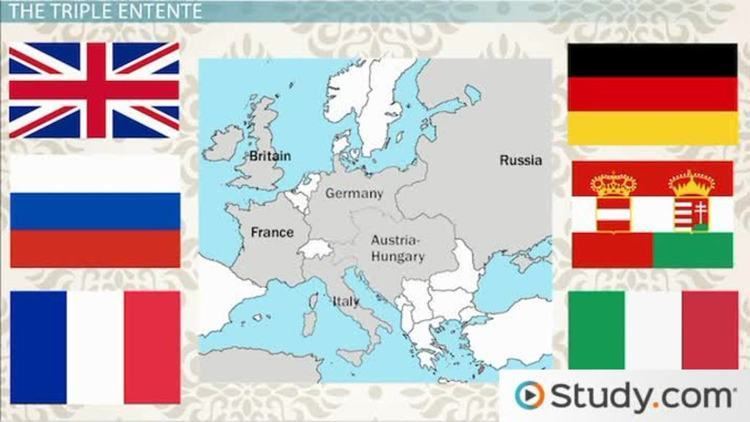 | ||
The Triple Entente (from French entente [ɑ̃tɑ̃t] "friendship, understanding, agreement") was the understanding linking the Russian Empire, the French Third Republic, and the United Kingdom of Great Britain and Ireland after the signing of the Anglo-Russian Entente on 31 August 1907. The understanding between the three powers, supplemented by agreements with Japan and Portugal, constituted a powerful counterweight to the Triple Alliance of Germany, Austria-Hungary and the Kingdom of Italy, though Italy did not side with Germany and Austria during World War I and joined the Entente Powers instead, in the 1915 Treaty of London.
Contents
- Alliances before ww1 triple alliance and triple entente gcse history
- French isolation
- Franco Russian Alliance
- Entente cordiale
- Anglo Russian Convention of 1907
- Britain
- French Third Republic
- Russian Empire
- References
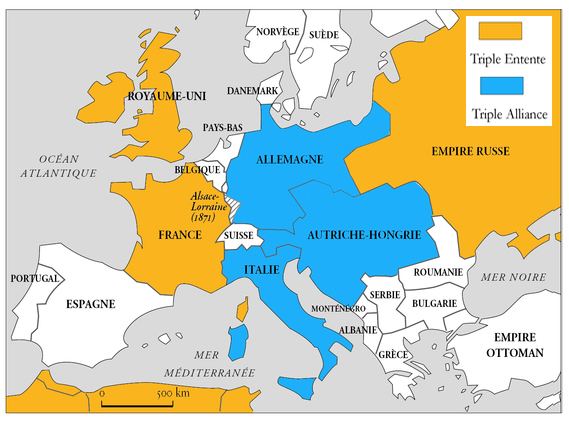
Historians continue to debate the importance of the alliance system in igniting the Great War. At the start of World War I in 1914, all three Triple Entente members entered it as Allies of World War I against the Central Powers, Germany and Austria-Hungary. However, it is important to note that the Triple Entente, in contrast to the Triple Alliance or the Franco-Russian Alliance, was not an alliance of mutual defence and Britain therefore felt free to make her own foreign policy decisions in the July crisis in 1914.
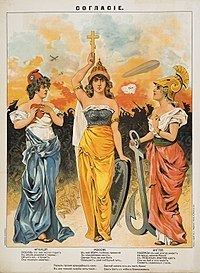
Alliances before ww1 triple alliance and triple entente gcse history
French isolation

Russia had previously been a member of the League of the Three Emperors with Austria-Hungary and Germany, an alliance established in 1873 between Tsar Alexander II, Emperor Franz Joseph I, and Kaiser Wilhelm I. The alliance was part of German Chancellor Otto von Bismarck′s plan to isolate France diplomatically; he feared France had revanchist aspirations and might try to regain its 1871 losses, and it also served to fight against progressive sentiments which the conservative rulers found unsettling, such as the First International.
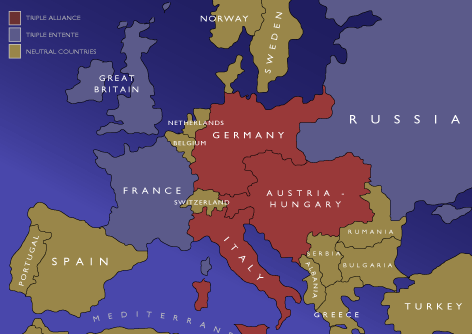
However, the League faced great difficulty with the growing tensions between the Russian Empire and Austria-Hungary, mainly over the Balkans, where the rise of nationalism and the continued decline of the Ottoman Empire made many former Ottoman provinces struggle for independence.
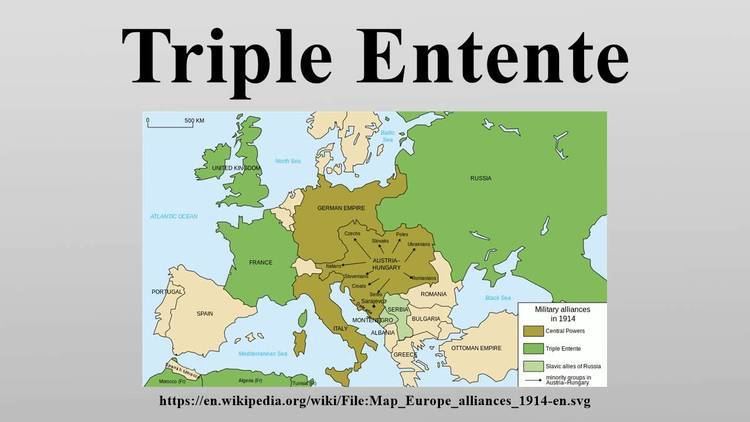
The situation in the Balkans (especially in the wake of the Serbo-Bulgarian War) and the 1878 Treaty of Berlin, which left Russia feeling cheated of its gains made in the Russo-Turkish War, led to the League not being renewed in 1887.
In an attempt to stop Russia from allying with France, Bismarck signed the secret Reinsurance Treaty with Russia in 1887. It assured that both parties would remain neutral toward each other if war broke out.
The alliance between Russia and France and Bismarck′s exclusion of Russia from the German financial market in 1887 prevented the treaty from being renewed in 1890, ending the alliance between Germany and Russia.
Franco-Russian Alliance
After the Reinsurance Treaty was not renewed in 1890, Russia's leaders grew alarmed at the country's diplomatic isolation and entered into the Franco-Russian Alliance in 1894.
Entente cordiale
In 1904 Britain and France signed a series of agreements, the Entente cordiale, directly concerning colonies.
The Entente heralded the end of British neutrality in Europe. It was partly a response to growing German antagonism, as expressed in the expansion of the Kaiserliche Marine (Imperial Navy) into a battle fleet that could threaten the supremacy of the Royal Navy.
The Entente, in contrast to the Triple Alliance or the Franco-Russian Alliance, was not an alliance of mutual defence and Britain was therefore free to make her own foreign policy decisions in 1914. As British Foreign Office Official Eyre Crowe minuted: "The fundamental fact of course is that the Entente is not an alliance. For purposes of ultimate emergencies it may be found to have no substance at all. For the Entente is nothing more than a frame of mind, a view of general policy which is shared by the governments of two countries, but which may be, or become, so vague as to lose all content".
Anglo-Russian Convention of 1907
In 1907 Britain and Russia signed an agreement called the Anglo-Russian Convention of 1907 to stop both countries' rivalry in Central Asia, The Great Game.
Britain
In the last decade of the nineteenth century, Britain continued its policy of "splendid isolation", with its primary focus on defending its massive overseas empire. However, by the early 1900s the German threat increased dramatically. Some in Britain thought it was in need of allies. For most of the nineteenth century, Britain had regarded France and Russia as its two most dangerous rivals, but with the growing threat of Germany, policy began to change for several reasons:
- France and Britain had signed five separate agreements regarding spheres of influence in North Africa in 1904, the Entente cordiale. The Tangier Crisis later encouraged co-operation between the two countries from their mutual fear of apparent German expansionism.
- Russia was defeated in the Russo-Japanese War, which resulted in less concern over Russian imperialism and encouraged Russia to secure its position elsewhere. France was already allied to Russia in the Dual Alliance.
- Britain was frightened about the rising threat of German imperialism. Kaiser Wilhelm II had announced to the world his intentions to create a global German empire and to develop a strong navy. Britain, traditionally having control of the seas, saw this as a serious threat to its own empire and navy.
- In 1907, the Anglo-Russian Entente was agreed, which attempted to resolve a series of long-running disputes over Persia, Afghanistan, and Tibet and helped to address British fears about German expansion in the Near East.
French Third Republic
During the Franco-Prussian War of 1870–1871, Prussia defeated the Second French Empire, resulting in the establishment of the Third Republic. In the Treaty of Frankfurt, Prussia forced France to cede Alsace-Lorraine to the new German Empire. Ever since, relations had been at an all time low. France, worried about the escalating military development of Germany, began building up its own war industries and army to deter to German aggression. As another measure, France developed a strong bond with Russia by ratifying the Franco-Russian Alliance, which was designed to create a strong counter to the Triple Alliance. France′s main concerns were to protect against an attack from Germany and regain Alsace-Lorraine.
Russian Empire
Russia possessed, by far, the largest manpower reserves of all the six European powers, but it was also the most backward economically. Russia shared France′s worries about Germany. After the Germans started to reorganize the Ottoman army, Russia feared that they would come to control the Dardanelles, a vital trade artery carrying two fifths of Russia's exports.
That was also coupled with Russia's long history of rivalry with Austria-Hungary. Austria-Hungary had recently annexed Bosnia and Herzegovina, greatly angering Russia, which had considered itself the leader of the Slavic world (Pan-Slavism). Russia viewed the invasion as another step towards annexing Serbia and Montenegro.
Russia had also recently lost the humiliating Russo-Japanese War in 1905, resulting in a revolutionary uprising and apparent transformation into a constitutional monarchy. To counter its enemies militarily and politically, Russia sought to revive the Franco-Russian Alliance. Although it was perceived as useless during the war with Japan, it was valuable in the European theatre. Russia signed the Anglo-Russian Convention of 1907 with Britain to counteract the threat of the Triple Alliance.
The alignment of the autocratic Russian Empire with Europe's two largest democracies was not without controversy on both sides. Many Russian conservatives mistrusted the secular French Republic and recalled British diplomatic maneuvers to block Russian influence in the Near East; in turn, prominent French and British journalists, academics, and parliamentarians found the reactionary tsarist regime distasteful. The mistrust persisted even during wartime, with British and French politicians expressing relief when Tsar Nicholas II abdicated in favor of a Provisional Government in 1917. An initial offer of political asylum for the Romanovs was subsequently withdrawn by the British government for fears of a public backlash. For the same reason, the French Republic never broached the subject of asylum with the deposed tsar.
